Preliminary Results of the Development of a DNA-Hybridization-Based Biosensor for the Detection of Milk Adulteration Using Gold Interdigitated Electrodes †
Abstract
:1. Introduction
2. Materials and Methods
2.1. Structure of the Biosensor
2.2. Development of Biosensor
2.2.1. Selection and Preparation of Samples
2.2.2. Prepatation of Primers
2.2.3. Preparation of Interdigitated Capacitors
2.2.4. Negative Control
2.2.5. DNA Detection
3. Results and Discussion
4. Conclusions
Author Contributions
Funding
Institutional Review Board Statement
Informed Consent Statement
Data Availability Statement
Conflicts of Interest
References
- Nagraik, R.; Sharma, A.; Kumar, D.; Chawla, P.; Kumar, A.P. Milk adulterant detection: Conventional and biosensor based approaches: A review. Sens. Bio-Sens. Res. 2021, 33, 100433. [Google Scholar] [CrossRef]
- Sakti, S.P.; Chabibah, N.; Ayu, S.P.; Padaga, M.C.; Aulanni’am, A. Development of QCM Biosensor with Specific Cow Milk Protein Antibody for Candidate Milk Adulteration Detection. J. Sens. 2016, 2016, 1807647. [Google Scholar] [CrossRef]
- Renny, E.; Daniel, D.; Krastanov, A.; Zachariah, C.; Elizabeth, R. Enzyme Based Sensor for Detection of Urea in Milk. Biotechnol. Biotechnol. Equip. 2005, 19, 198–201. [Google Scholar] [CrossRef]
- Poonia, A.; Jha, A.; Sharma, R.; Singh, H.B.; Rai, A.K.; Sharma, N. Detection of adulteration in milk: A review. Int. J. Dairy Technol. 2016, 70, 23–42. [Google Scholar] [CrossRef]
- Hlongwane, G.N.; Dodoo-Arhin, D.; Wamwangi, D.; Daramola, M.O.; Moothi, K.; Iyuke, S.E. DNA hybridisation sensors for product authentication and tracing: State of the art and challenges. S. Afr. J. Chem. Eng. 2018, 27, 16–34. [Google Scholar] [CrossRef]
- Kowalczyk, A. Trends and perspectives in DNA biosensors as diagnostic devices. Curr. Opin. Electrochem. 2020, 23, 36–41. [Google Scholar] [CrossRef]
- Wang, L.; Veselinovic, M.; Yang, L.; Geiss, B.J.; Dandy, D.S.; Chen, T. A sensitive DNA capacitive biosensor using interdigitated electrodes. Biosens. Bioelectron. 2016, 87, 646–653. [Google Scholar] [CrossRef] [PubMed]
- Mazlan, N.S.; Ramli, M.M.; Abdullah, M.M.A.B.; Halin, D.S.C.; Isa, S.S.M.; Talip, L.F.A.; Danial, N.S.; Murad, S.A.Z. Interdigitated electrodes as impedance and capacitance biosensors: A review. AIP Conf. Proc. 2017, 1885, 020276. [Google Scholar] [CrossRef]
- Georgas, A.; Lampas, E.; Houhoula, D.; Skoufias, A.; Patsilinakos, S.; Tsafaridis, I.; Patrinos, G.; Adamopoulos, N.; Ferraro, A.; Hristoforou, E. ACE2-based capacitance sensor for rapid native SARS-CoV-2 detection in biological fluids and its correlation with real-time PCR. Biosens. Bioelectron. 2022, 202, 114021. [Google Scholar] [CrossRef] [PubMed]
- Georgas, A.; Agiannis, K.; Papakosta, V.; Priftis, P.; Angelopoulos, S.; Ferraro, A.; Hristoforou, E. A Biosensor Platform for Point-of-Care SARS-CoV-2 Screening. Biosensors 2022, 12, 487. [Google Scholar] [CrossRef] [PubMed]
- Ortiz, J.M.L.; Tsouknidas, C.; Pytel, S.; Papatheodorou, S.; Vougiouklaki, D.; Tsakni, A.; Antonopoulos, D.; Tsakali, E.; Van Impe, J.; Houhoula, D. Effectual Gold Nanoprobe Sensor for Screening Cow Milk Adulteration in Goat Milk—Comparison with Conventional PCR. J. Agric. Sci. 2021, 13, 41. [Google Scholar] [CrossRef]
- Rashid, J.I.A.; Yusof, N.A. The strategies of DNA immobilization and hybridization detection mechanism in the construction of electrochemical DNA sensor: A review. Sens. Bio-Sens. Res. 2017, 16, 19–31. [Google Scholar] [CrossRef]
- Mafra, I.; Honrado, M.; Amaral, J.S. Animal Species Authentication in Dairy Products. Foods 2022, 11, 1124. [Google Scholar] [CrossRef] [PubMed]
- Hong, Y.; Birse, N.; Quinn, B.; Montgomery, H.; Di Wu, D.; da Silva, G.R.; van Ruth, S.M.; Elliott, C.T. Identification of milk from different animal and plant sources by desorption electrospray ionisation high-resolution mass spectrometry (DESI-MS). NPJ Sci. Food 2022, 6, 14. [Google Scholar] [CrossRef] [PubMed]
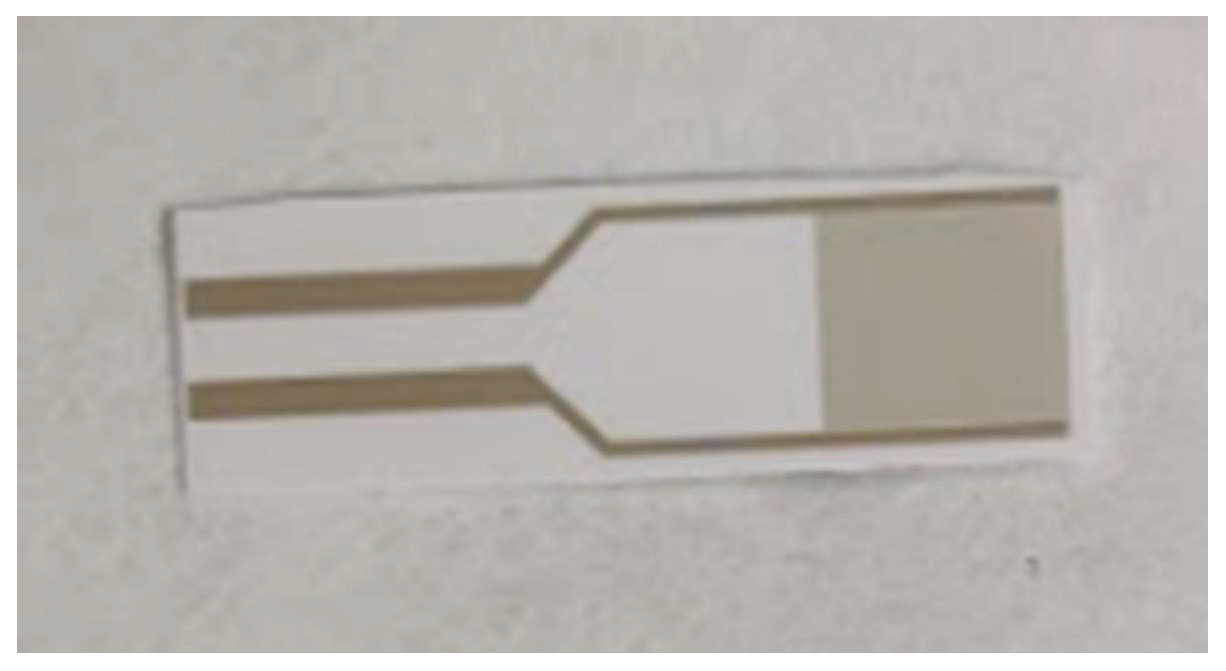
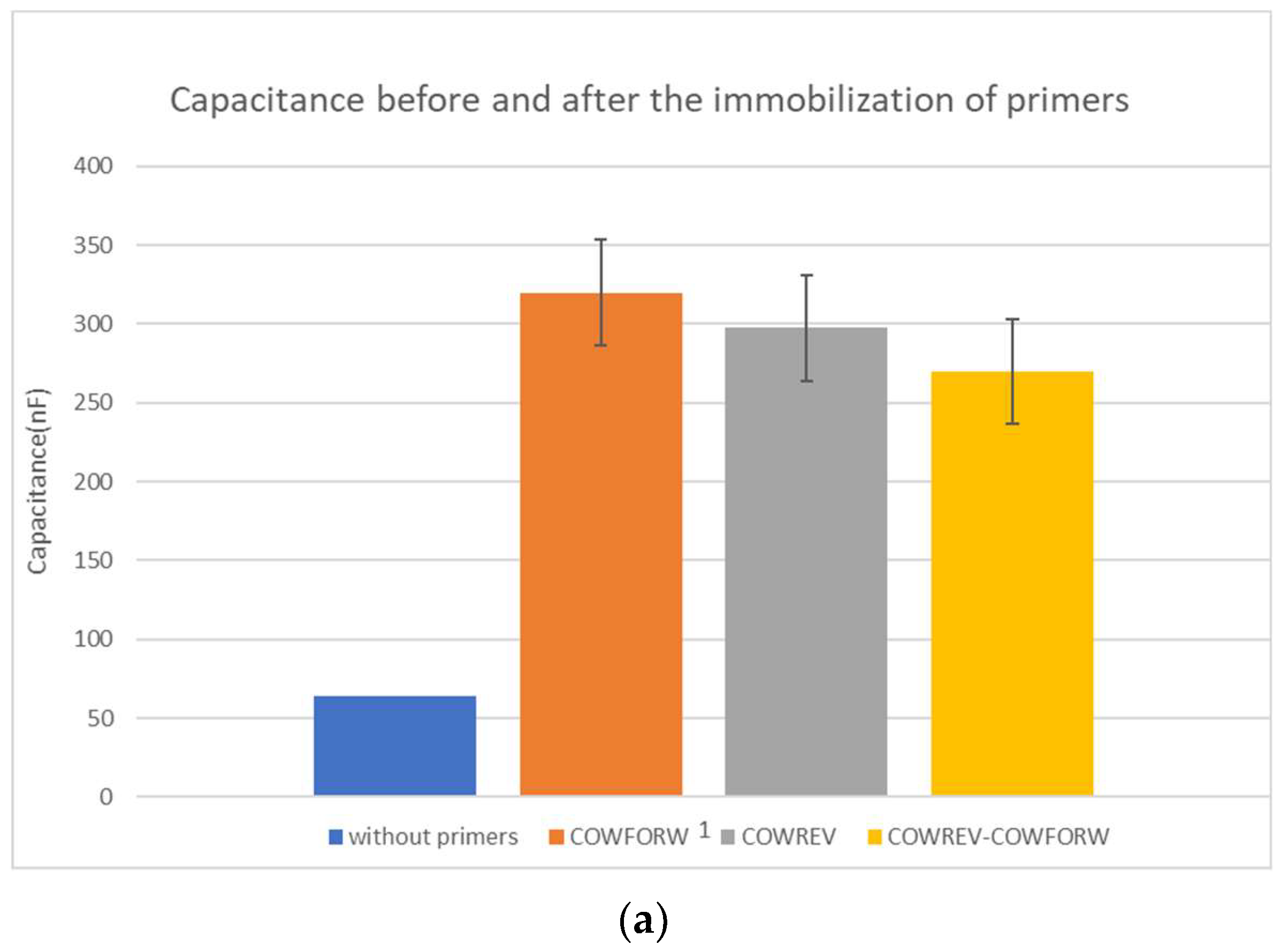
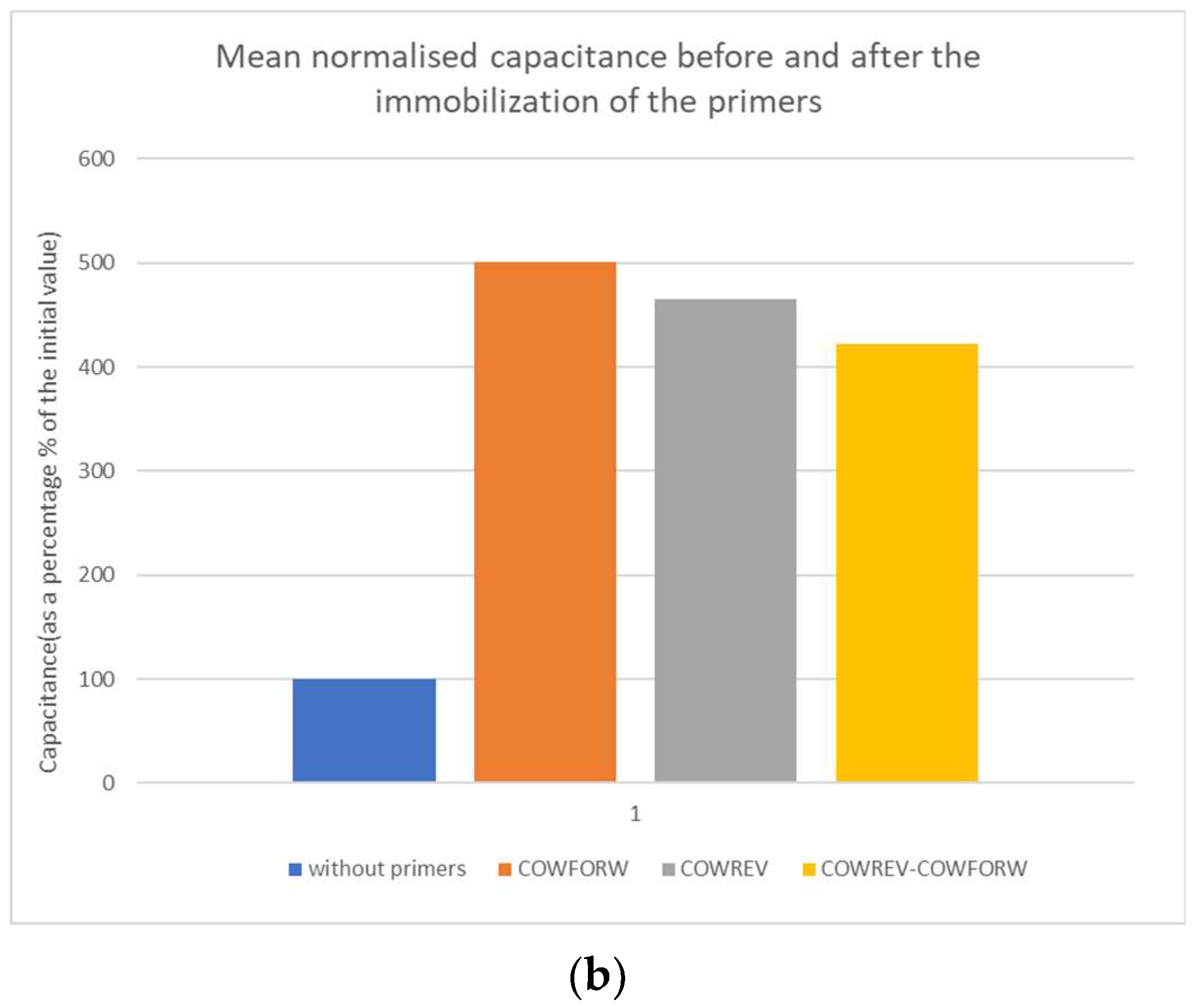
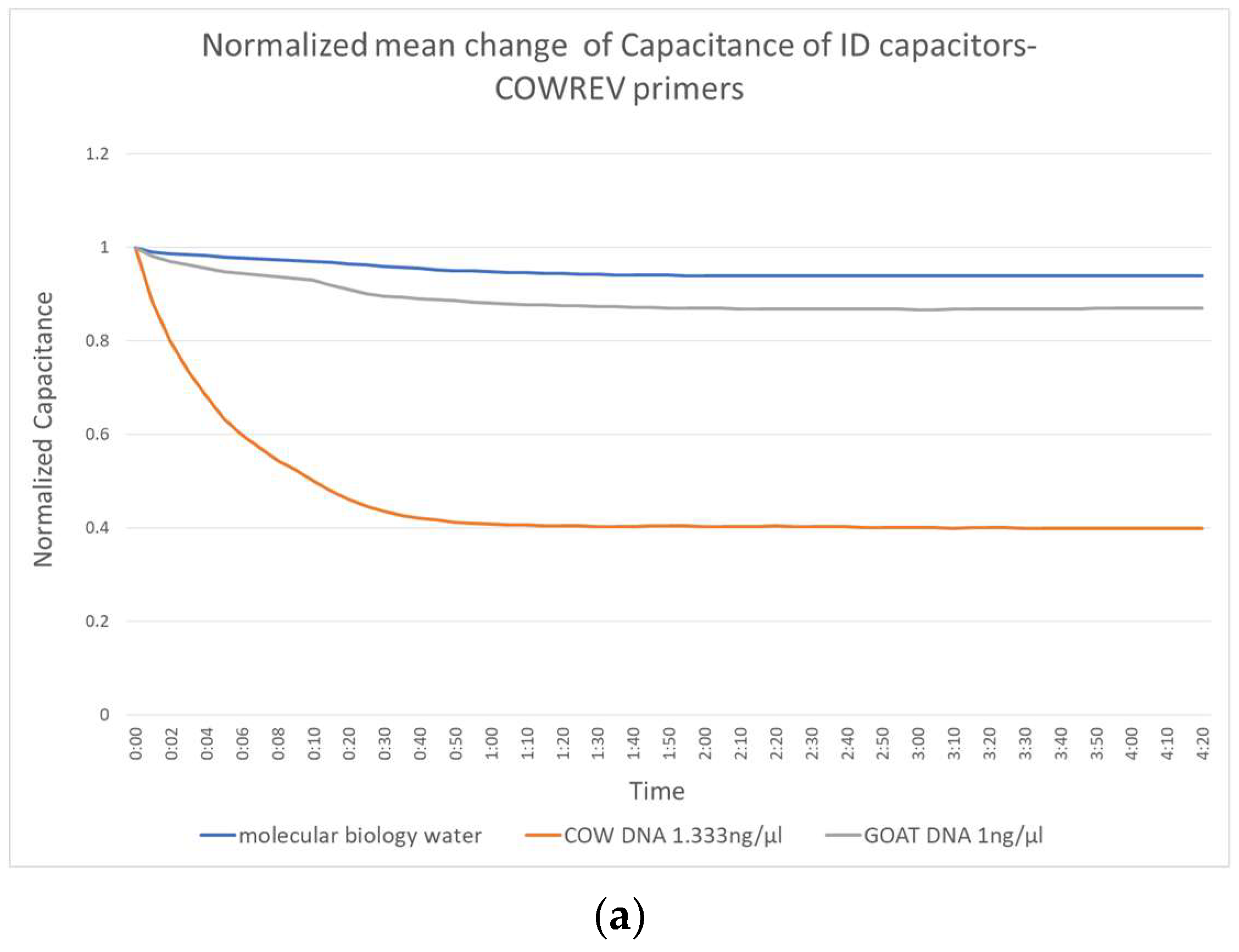
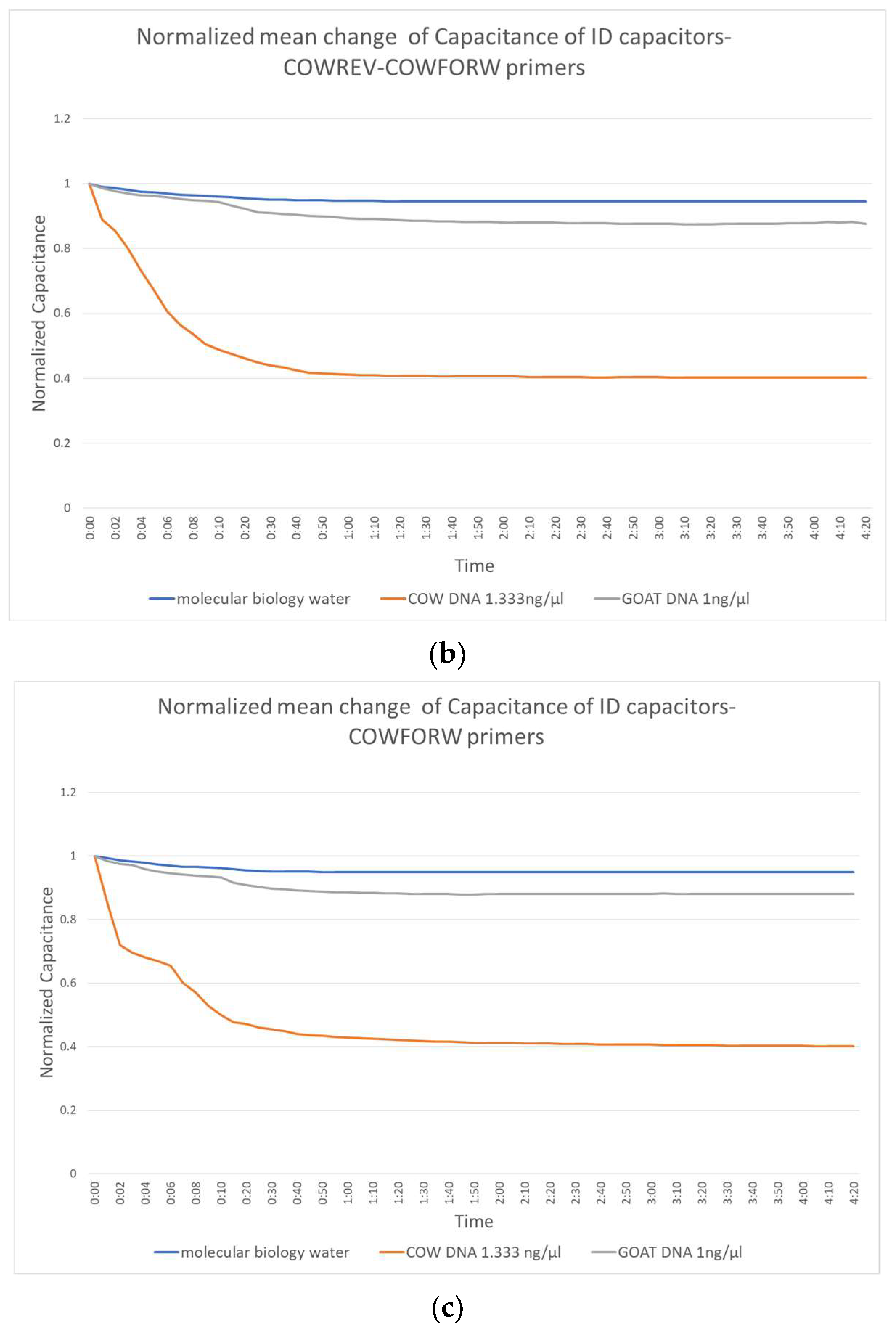
| COWFORW | COWREV | COWFORW-COWREV | |
|---|---|---|---|
| Mean Value (nF) | 319.841 | 297.358 | 269.834 |
| Mean Value Cafter/Cbefore (%) | 500.534 | 465.350 | 422.276 |
| Standard Deviation | 33.371 | 50.651 | 22.598 |
Disclaimer/Publisher’s Note: The statements, opinions and data contained in all publications are solely those of the individual author(s) and contributor(s) and not of MDPI and/or the editor(s). MDPI and/or the editor(s) disclaim responsibility for any injury to people or property resulting from any ideas, methods, instructions or products referred to in the content. |
© 2023 by the authors. Licensee MDPI, Basel, Switzerland. This article is an open access article distributed under the terms and conditions of the Creative Commons Attribution (CC BY) license (https://creativecommons.org/licenses/by/4.0/).
Share and Cite
Karkani, D.; Georgas, A.; Houhoula, D.P.; Ferraro, A.; Hristoforou, E. Preliminary Results of the Development of a DNA-Hybridization-Based Biosensor for the Detection of Milk Adulteration Using Gold Interdigitated Electrodes. Eng. Proc. 2023, 35, 9. https://doi.org/10.3390/IECB2023-14567
Karkani D, Georgas A, Houhoula DP, Ferraro A, Hristoforou E. Preliminary Results of the Development of a DNA-Hybridization-Based Biosensor for the Detection of Milk Adulteration Using Gold Interdigitated Electrodes. Engineering Proceedings. 2023; 35(1):9. https://doi.org/10.3390/IECB2023-14567
Chicago/Turabian StyleKarkani, Dimitra, Antonios Georgas, Dimitra P. Houhoula, Angelo Ferraro, and Evangelos Hristoforou. 2023. "Preliminary Results of the Development of a DNA-Hybridization-Based Biosensor for the Detection of Milk Adulteration Using Gold Interdigitated Electrodes" Engineering Proceedings 35, no. 1: 9. https://doi.org/10.3390/IECB2023-14567
APA StyleKarkani, D., Georgas, A., Houhoula, D. P., Ferraro, A., & Hristoforou, E. (2023). Preliminary Results of the Development of a DNA-Hybridization-Based Biosensor for the Detection of Milk Adulteration Using Gold Interdigitated Electrodes. Engineering Proceedings, 35(1), 9. https://doi.org/10.3390/IECB2023-14567









